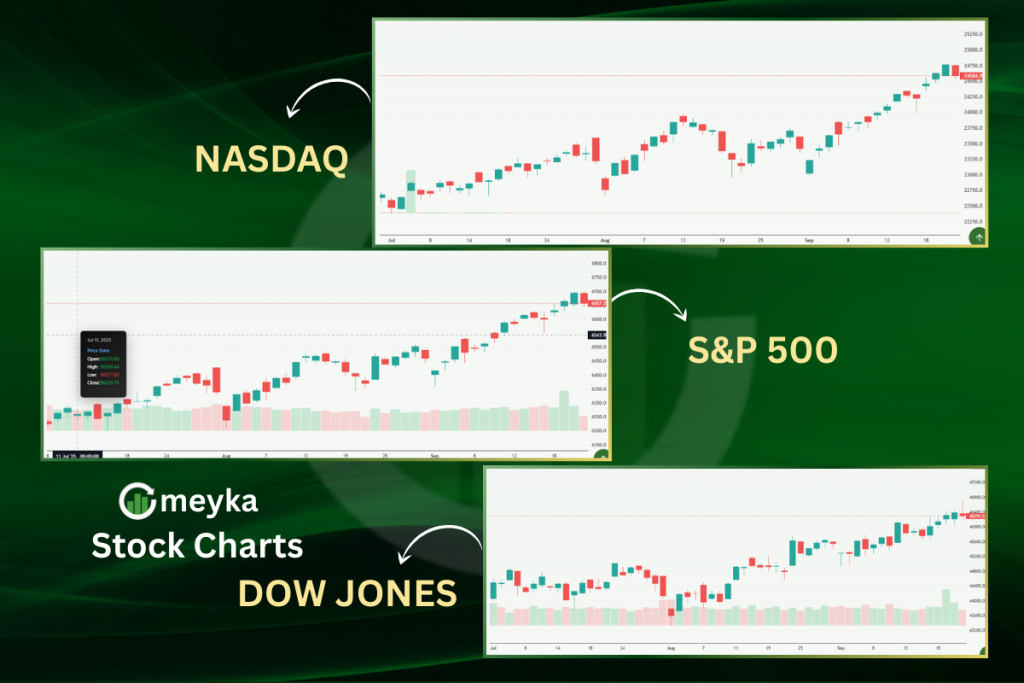Stock Market Update: Dow, S&P 500, Nasdaq Futures Flat Ahead of Key CPI Data
U.S. stock market futures held steady early Tuesday as traders waited for the upcoming Consumer Price Index reading. The Dow Jones, S&P 500, and Nasdaq futures were little changed, showing that many investors are pausing for fresh inflation signals before making big bets. The soft tone in futures reflects caution about how the CPI print could shape the Federal Reserve’s next policy steps.
Market coverage from Yahoo Finance and analysis from TipRanks framed the mood as one of measured wait and watch ahead of the report.
Why is the CPI data so important for investors? Because it often decides the timing of rate cuts and risk appetite on Wall Street.
Stock Market Holds Steady Before Key CPI Report
U.S. stock futures were mostly flat as traders weighed whether inflation is cooling enough to speed up Fed rate cuts. The move was not dramatic; it was a cautious pause.
Dow futures showed minor losses, while S&P futures were close to unchanged, and Nasdaq 100 futures were slightly positive in after-hours trade. Bond yields and the U.S. dollar were muted, reinforcing the idea that markets are holding their breath for the data.
Traders and commentators on social platforms captured that mood, noting the calm before the inflation report hits the tape.
Why CPI Data Matters for the Stock Market
The Consumer Price Index measures changes in consumer prices across the economy. It is the headline gauge investors use to judge inflation trends. The Fed watches CPI closely when it chooses interest rate policy.
If inflation stays hot, the Fed may delay rate cuts. That would pressure stocks, especially growth names. If CPI cools, markets may rally on hopes of easier policy.
Core CPI, which strips out food and energy, is watched even more closely because it shows underlying price pressure. Analysts say the Fed’s next moves will depend on these core readings.
Dow, S&P 500, and Nasdaq Futures Reaction in Early Trading

In premarket action, the Dow Jones futures edged down very modestly, the S&P 500 futures were largely unchanged, and the Nasdaq 100 futures showed a fractional gain. Investors cited a lack of conviction ahead of prints and recent earnings.
Big tech names like Apple (AAPL), Microsoft (MSFT), Tesla (TSLA), and Nvidia (NVDA) were calm after a week of major results. Many traders prefer to let the CPI landing decide how to reposition. Low volume and thin trade accompanied the subdued futures session, a common pattern before major economic releases.
What Analysts Expect from the CPI Report
Economists polled by market outlets peg the month-over-month CPI change at around 0.3 percent. Core readings are expected to remain the key focus. If core inflation surprises to the upside, markets may price in a longer wait for Fed easing. If core inflation comes in softer, traders could price in earlier rate cuts, lifting equities.
Analysts at TipRanks and other research desks have cautioned that markets may swing quickly on even small deviations from expectations. The two clear scenarios are a relief rally on a soft print or a short-term sell-off on a hotter print.
Global Market Mood and Economic Indicators
Global markets reflected the same cautious tone. Asian bourses opened mixed with small gains in selective markets, while European indices were steady ahead of U.S. data. Commodities and safe-haven assets moved in line with risk appetite: crude oil was stable, gold was little changed, and Treasury yields barely moved.
IndexBox and other market commentators noted that global investors are bracing for volatility given the importance of the CPI figure to policy and to cross-border capital flows.
The market microstructure is clear: traders want the data before taking large-scale directional risk.
What Could Drive the Stock Market After the CPI Report
If CPI shows clear signs of cooling, the Dow and S&P 500 could extend gains as investors price in easing policy. Growth and tech stocks could rally more if rate cut odds rise. If CPI surprises on the upside, expect pressure on growth names and a rotation toward defensive sectors and value.
Bond yields would likely move higher, and the dollar could strengthen, both of which can be negative for equities. Traders will also be watching comments from Fed officials and any guidance on the timing of cuts. That follow-up commentary often matters as much as the raw data.
Investor Sentiment and Trading Trends Ahead of Inflation Data
Positioning ahead of the CPI showed a tilt toward caution. Some funds trimmed cyclical exposure and increased cash buffers. Others shifted into defensive sectors like utilities and consumer staples, which tend to hold up better during rate uncertainty.
Energy names saw selective interest as markets priced in fluctuating crude costs, while banking stocks moved modestly as yields were eyed.
Yahoo Finance coverage highlighted that many retail and institutional players prefer smaller, tactical trades until the inflation picture clears up.
How Economic Context Shapes Market Moves
CPI does not operate alone. Traders will read the print alongside recent jobs data, producer prices, and global economic signals. If the labor market cools and producer prices ease, CPI softness would be more convincing.
Conversely, if other indicators stay firm, a single soft CPI number may not alter Fed expectations. Markets will also factor in global supply patterns, energy trends, and the next Fed meeting minutes when deciding whether to press gains or pare positions. In short, the CPI is a major piece, not the only piece.
The Road Ahead for the Stock Market After CPI
All eyes are on the CPI release and the immediate market reaction. A stable or cooling CPI number could ease concerns about inflation and help the stock market renew its upward march.
A hotter print would likely bring near-term volatility and push investors toward cautious positioning. For now, futures are flat because traders prefer clarity over conjecture.
As the data lands, markets will show whether optimism or caution leads the next phase of trading. Watch crude, yields, and Fed commentary to see how the story unfolds.
FAQ’S
Yes, CPI data strongly affects the stock market because it shows inflation trends that influence Federal Reserve interest rate decisions. Higher inflation usually hurts stocks, while lower inflation often boosts them.
The U.S. stock market is trading cautiously today, with the Dow, S&P 500, and Nasdaq moving flat to slightly lower as investors await key inflation and earnings data.
The stock market is falling mainly due to fears of sticky inflation, higher bond yields, and delayed Fed rate cuts, which reduce investor appetite for risk assets like equities.
The Dow dropped 800 points as investors reacted to stronger-than-expected inflation data and renewed worries about higher-for-longer interest rates, sparking broad-based selling across sectors.
Disclaimer
The content shared by Meyka AI PTY LTD is solely for research and informational purposes. Meyka is not a financial advisory service, and the information provided should not be considered investment or trading advice.”






